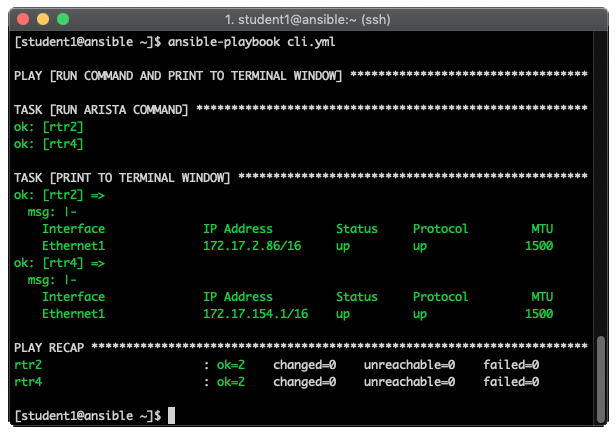Deep Dive on cli_command for Network Automation
Deep Dive on cli_command for Network Automation
In October Ansible 2.7 was released and brought us two powerful agnostic network modules, cli_command and cli_config. Do you have two or more network vendors within your environment? The goal of agnostic modules is to simplify Ansible Playbooks for network engineers that deal with a variety of network platforms. Rather than having to deal with platform specific modules (e.g. eos_config, ios_config, junos_config), you can now use cli_command or cli_config to reduce the amount of tasks and conditionals within a playbook, and make the playbook easier to use. This post will demonstrate how to use these modules and contrast them to platform specific modules. I'll show some playbook examples and common use cases to help illustrate how you can use these new platform agnostic modules.
Both the cli_command and cli_config only work with the
network_cli connection plugin.
The goal of network_cli is to make playbooks look, feel and operate on
network devices, the same way Ansible works on Linux hosts.
What can you do with the cli_command?
The cli_command allows you to run arbitrary commands on network devices. Let's show a simple example using the cli_command, on an Arista vEOS device.
--- - name: RUN COMMAND AND PRINT TO TERMINAL WINDOW hosts: arista gather_facts: false tasks: - name: RUN ARISTA COMMAND cli_command: command: show ip interface brief register: command_output - name: PRINT TO TERMINAL WINDOW debug: msg: "{{command_output.stdout}}"
Previously this would require the eos_command module and would look like this:
--- - name: RUN COMMAND AND PRINT TO TERMINAL WINDOW hosts: arista gather_facts: false tasks: - name: RUN ARISTA COMMAND eos_command: commands: show ip interface brief register: command_output - name: PRINT TO TERMINAL WINDOW debug: msg: "{{command_output.stdout}}"
Both Ansible Playbooks are simple and will output identically. This is what it would look like:

Now these two playbooks don't look much different yet, but when you add multiple vendors the playbook complexity without these new agnostic network modules can increase quickly. Previously if I had a mixed vendor environment, I would see the playbook evolve a couple different ways. Sometimes they would contain numerous conditionals (the when statement) like this:
- name: RUN ARISTA COMMAND eos_command: commands: show ip int br when: ansible_network_os == 'eos' - name: RUN CISCO NXOS COMMAND nxos_command: commands: show ip int br when: ansible_network_os == 'nxos' - name: RUN JUNOS COMMAND junos_command: commands: show interface terse when: ansible_network_os == 'junos'
Or somewhat better, network automation playbooks would evolve like this:
- name: RUN JUNOS COMMAND include_tasks: “{{ansible_network_os}}”
This second method is much cleaner. The include_tasks calls an Ansible Playbook named eos.yml, ios.yml, nxos.yml, etc and runs the corresponding command or tasks that were needed. While this is much better because you can separate Ansible Playbooks based on the network platform, it is still not as succinct or easy as agnostic modules. The underlying functionality is the same, but the Ansible Playbooks become much simpler.
The reason I bring up this include_tasks method is that there is still going to be a time and place, even with agnostic modules, to separate out the playbook logic. For example the command shown above for Juniper is different compared to Arista and Cisco (show ip interface brief versus show interface terse).
With the cli_command let's look at how we can make this agnostic playbook for Cisco, Juniper and Arista extremely simple:
--- - name: RUN COMMAND AND PRINT TO TERMINAL WINDOW hosts: routers gather_facts: false tasks: - name: RUN SHOW COMMAND cli_command: command: "{{show_interfaces}}" register: command_output - name: PRINT TO TERMINAL WINDOW debug: msg: "{{command_output.stdout}}"
Three *os_command tasks are reduced to one task. The show_interfaces
variable is stored as a group variable on a per-platform basis. For a
full example look at this GitHub repository.
Backup example
Let's look at another use-case with the cli_command module. Backing up network configurations is a common network operational task. Ansible Network Automation modules have a backup parameter that helps network engineers automate this mundane, yet critical, task. For example with Arista EOS we can do this:
--- - name: BACKUP NETWORK CONFIGURATIONS hosts: arista gather_facts: false tasks: - name: BACKUP CONFIG eos_config: backup: yes
The cli_command module does not have a backup parameter. Why? Because the backup parameter can be quite inflexible and hard to manipulate. One of the most common feature requests from Ansible users is for every config module to be able to set the backup destination. Rather than recreate an incredible amount of logic and code in each config module, we can reuse an existing module. In this case we can leverage the already widely used copy module!
--- - name: RUN COMMAND AND PRINT TO TERMINAL WINDOW hosts: arista gather_facts: false tasks: - name: RUN ARISTA COMMAND cli_command: command: show run register: backup - name: PRINT TO TERMINAL WINDOW copy: content: "{{backup.stdout}}" dest: "{{inventory_hostname}}.backup"
This becomes easy to manipulate what command output we want to save. In this case it is the running configuration, but now we can switch to startup-config just as easily. It also gives the user the control to pick the backup destination directory and file name. An example of an agnostic playbook for backups for Arista EOS, Juniper Junos and Cisco IOS can be found here:
https://github.com/network-automation/agnostic_example
There are a lot of incredible things we can do with the agnostic modules that help make our Ansible Network Automation Playbooks much more succinct and simple. The cli_comand and cli_config modules have been in the Ansible project since October 2018. Consider upgrading if you have not already. If you are already using the cli_command or cli_config module, please share! I will be highlighting more examples using agnostic modules in subsequent blog posts so stay tuned.